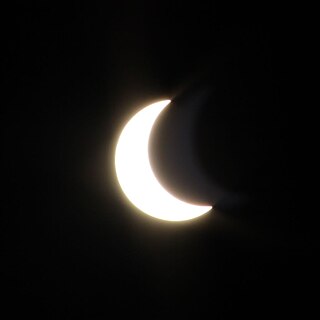| Solar eclipse of February 26, 2017 | |
|---|---|
 Partial from Buenos Aires, Argentina | |
| Type of eclipse | |
| Nature | Annular |
| Gamma | −0.4578 |
| Magnitude | 0.9922 |
| Maximum eclipse | |
| Duration | 44 s (0 min 44 s) |
| Coordinates | 34°42′S 31°12′W / 34.7°S 31.2°W |
| Max. width of band | 31 km (19 mi) |
| Times (UTC) | |
| Greatest eclipse | 14:54:33 |
| References | |
| Saros | 140 (29 of 71) |
| Catalog # (SE5000) | 9545 |
An annular solar eclipse occurred at the Moon's descending node of orbit on Sunday, February 26, 2017,[1][2][3][4] with a magnitude of 0.9922. A solar eclipse occurs when the Moon passes between Earth and the Sun, thereby totally or partly obscuring the image of the Sun for a viewer on Earth. An annular solar eclipse occurs when the Moon's apparent diameter is smaller than the Sun's, blocking most of the Sun's light and causing the Sun to look like an annulus (ring). An annular eclipse appears as a partial eclipse over a region of the Earth thousands of kilometres wide. Occurring about 4.9 days before perigee (on March 3, 2017, at 13:30 UTC), the Moon's apparent diameter was larger.[5]
The eclipse was visible across southern Chile and Argentina in the morning and ended in Angola and southwestern Katanga, Democratic Republic of the Congo at sunset. In Argentina, the best places to see the eclipse were located in the south of the Chubut Province, in the towns of Facundo, Sarmiento and Camarones. A partial eclipse was visible for parts of southern South America, southern and western Africa, and Antarctica.
- ^ "February 26, 2017 Annular Solar Eclipse". timeanddate. Retrieved 12 August 2024.
- ^ Cite error: The named reference
spacewas invoked but never defined (see the help page). - ^ Cite error: The named reference
nprwas invoked but never defined (see the help page). - ^ Cite error: The named reference
cbswas invoked but never defined (see the help page). - ^ "Moon Distances for London, United Kingdom, England". timeanddate. Retrieved 12 August 2024.
